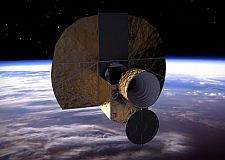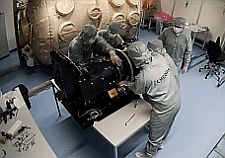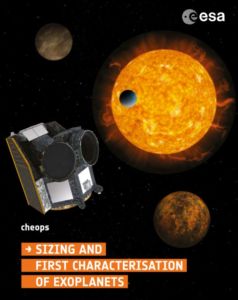
CHEOPS – Characterising ExOPlanet Satellite
CHEOPS is a small photometric observatory launched into low Earth orbit to measure transits of exoplanets. CHEOPS is the first small-class mission from ESA, selected in October 2012 and launched on 18 December 2019. ESA was the Mission Architect and in charge of the spacecraft development and launcher procurement. The Member States’ contribution was led by the University of Bern (UBE). The mission’s main science goal is to search for transits by means of ultra-high precision photometry on bright stars already known to host planets.
By being able to point at nearly any location on the sky, it provides the unique capability of determining accurate radii for a subset of those planets for which the mass has already been estimated from ground-based spectroscopic surveys. It also provides precision radii for new planets discovered by the next generation ground-based transits surveys (Neptune-size and smaller). The mission is flying a single medium-size telescope (30 cm aperture, 1.2 m length including baffle). All platform requirements were aimed at supporting the functionality of the telescope and its ultrahigh photometric precision. The main implications for the platform are related to pointing capabilities and thermal environment for the payload.
TECHNICAL OBJECTIVE
TECHNICAL OBJECTIVE was to develop two radiator assemblies for the scientific instrument of the CHEOPS satellite. Proper thermal control at instrument and spacecraft level is one of the key components to mission success. The Focal Plane Array (FPA) requires 10mK, while the Front-end Electronics (FEE) require 50 mK temperature stability with -55 °C and -10 °C operational temperatures. The FPA radiator and the associated FEE radiator are responsible to keep these equipments at optimum working temperature in all mission phases, while the operational temperature range of spacecraft is between -70 and +40 °C. Admatis was responsible for the Structural and Thermal Model (STM) and the Proto Flight Model (FPM) delivery. Design activity included thermal and structural FE analysis to optimize mechanical and thermal properties. The raw material of radiators is aluminium alloy, baseline machining processes are CNC milling and turning. Radiators were chromate conversion coated to improve corrosion resistance and adhesion to paints and glues. Radiative areas were coated with thermal control system (white paint or secondary surface mirror, SSM) to ensure the proper heat rejecting. Vacuum bake-out will be performed to remove organic contaminants and residues of solvents or other volatiles. Verification included the mechanical and thermal tests. A large number of MGSE tools have been developed for environmental tests which were also managed by ADMATIS.
STATUS
In December 2019, the CHEOPS satellite has arrived to Kourou. CHEOPS was successfully launched on 18 December 2019.
THE SCIENCE BEHIND CHEOPS
An exoplanet or extrasolar planet is a planet that orbits a star other than the Sun, a stellar remnant, or a brown dwarf. The CHEOPS satellite will investigate exoplanets with the transit photometry method. This method can determine the radius of a planet. If a planet crosses (transits) in front of the disk of its parent star, then the observed visual brightness of the star drops a small amount. The amount the star dims depends on the relative sizes of the star and the planet. When combined with the radial-velocity method (wich determines the planet’s mass), one can determine the density of the planet and learn something about the planet’s physical structure. The transit method also makes it possible to study the atmosphere of a planet.





